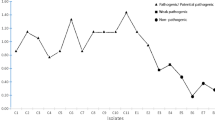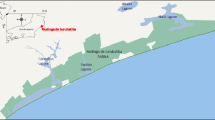Abstract
Bacteriolytic activities of axenically grown free-living soil amoebaeAcanthamoeba castellanii, Acanthamoeba polyphaga andHartmannella vermiformis towards various Gram-positive and Gram-negative bacteria were determined. A spectrophotometric assay revealed that the specific bacteriolytic activities of bothAcanthamoeba species were higher as those of the threeHartmannella strains.Bacillus megaterium, Bacillus subtilis, Chromatium vinosum, Micrococcus luteus andPseudomonas fluorescens were more easily lysed than the other bacteria tested.Agrobacterium tumefaciens, Klebsiella aerogenes andSerratia marcescens were hardly affected at all by the amoebal bacteriolytic activities. Among the Gram-negative bacteria we observed differences in lysis sensitivity while the Gram-positive bacteria tested were sensitive to lysis. Isoelectric focusing (IEF) gel-electrophoresis in the pH range 3–10 was performed to separate the bacteriolytic isoenzymes of amoebae. Bacteriolytic patterns were shown by using an activity assay in which lysis bands were formed in the agar/bacteria gel-overlay. The activity assay revealed remarkable differences in typical banding patterns for bacteriolytic activities among amoebae. Distinct differences between typical pI points of bacteriolytic activities inAcanthamoeba andHartmannella were shown. Bacteriolytic activities ofHartmannella were more pronounced and observed in the isoelectric points (pI) range of 4.0–9.3 while forAcanthamoeba the range was pI 4.5–8.9.
Similar content being viewed by others
Abbreviations
- IEF:
-
isoelectric focusing
- PAA-IEF:
-
polyacrylamide-isoelectric focusing
- CCAP:
-
culture collection of algae and protozoa
- AS:
-
amoeba saline medium
- pI:
-
isoelectric points
References
Arnheim N, Hindenburg A, Begg GS & Morgan FJ (1973) Multiple genes for lysozyme in birds. J. Biol. Chem. 248: 8036–8042
Berger D & Mannheim W (1970) Anreicherung und Characterisierung eines bakteriolytischen Amöbenenzyms. Z. Naturforsch. 256: 1002–1010
Drozanski W (1969a) Bacteriolytic enzyme produced byAcanthamoeba castellanii. Acta Microbiol. Polon. 18: 155–168
Drozanski W (1969b) Bacteriolytic spectrum of the enzyme produced byAcanthamoeba castellanii. Acta Microbiol. Polon. 18: 169–174
Drozanski W (1972a) Enzymatic mode of action of the bacteriolytic enzyme fromAcanthamoeba castellanii. Acta Microbiol. Polon. 21: 53–62
Drozanski W (1972b) Purification and properties of bacteriolytic enzyme produced byAcanthamoeba castellanii. Acta Microbiol. Polon. 21: 33–52
Drozanski W (1978a) Activity and distribution of bacteriolytic N-acetyl-muramidase during growth ofAcanthamoeba castellanii in axenic culture. Acta Microbiol. Polon. 27: 243–256
Drozanski W (1978b) Two forms of bacteriolytic endo-N-acetylmuramidase inAcanthamoeba castellanii. Acta Biochimica Polon. 25: 229–238
Ginsburg I (1988) The biochemistry of bacteriolysis: paradoxes, facts and myths. Microbiol. Sci. 5: 137–142
Goldstone A & Koenig H (1974a) Autolysis of glycoproteins in rat kidney lysosomes in vitro; Effects on the isoelectric focusing behaviour of glycoproteins, arylsulphatase, and β-glucuronidase. Biochem. J. 141: 527–535
Goldstone A & Koenig H (1974b) Synthesis and turnover of lysosomal glycoproteins; Relation to the molecular heterogeneity of lysosomal enzymes. FEBS letters 39: 176–181
Hemelt DM, Mares B & Upadhyay JM (1979) Specificity of bacteriolytic enzyme II from a soil amoeba,Hartmannella glebae. Appl. Environm. Microbiol. 38: 373–378
Hermann J, Jollès J & Jollès P (1971) Multiple forms of duck-egg-white lysozyme.-Primary structure of two duck lysozymes. Eur. J. Biochem. 24: 12–17
Hindenburg A, Spitznagel J & Arnheim N (1974) Isoenzymes of lysozyme in leukocytes and egg-white: evidence for the speciesspecific control of egg-white lysozyme synthesis. Proc. Natl. Acad. Sci. USA. 71: 1653–1657
Jollès P, Bernier I, Berthou J, Charlemange D, Faure A, Hermann J, Jollès J, Périn JP & Saint-Blanchard J (1974) From lysozyme to chitinases; Structural, kinetic and crystallographic studies. In: Osserman EF, Canfield RE & Beychok S (ed) Lysozyme (pp 31–54). Academic Press Inc., New York
Katz W, Berger D & Martin HH (1971) Action of an N-acetylmuramidase from a limax amoeba on the murein ofProteus mirabilis. Biochim. Biophys. Acta 244: 47–57
Page FC (1988) A new key to freshwater and soil gymnamoebae, Culture Collection of Algae and Protozoa. Freshwater Biological Association, Ambleside, Cumbria, 16–17
Rosenthal S, Reed EJ & Weisman RA (1969) Effect of lytic enzymes ofAcanthamoeba castellanii on bacterial cell walls. J. Bacteriol. 98: 182–189
Stahl P, Six H, Rodman JS, Schlesinger P, Tulsiani DRP & Touster O (1976) Evidence for specific recognition sites mediating clearance of lysosomal enzymes in vivo. Proc. Natl. Acad. Sci. USA. 73: 4045–4049
Upadhyay JM (1968) Growth and bacteriolytic activity of a soil amoeba,Hartmannella glebae. J. Bacteriol. 95: 771–774
Upadhyay JM & Difulco TJ (1972) Isolation, purification, and properties of a second bacteriolytic enzyme fromHartmannella glebae. Arch. Biochem. Biophys. 149: 470–475
Upadhyay JM, Mares BA, Hemelt DM & Rivet PG (1977) Purification and specificity of bacteriolytic enzyme I fromHartmannella glebae. Appl. Environ. Microbiol. 33: 1–5
Weekers PHH & van der Drift C (1993) Nitrogen metabolizing enzyme activities in the free-living soil amoebaeAcanthamoeba castellanii, Acanthamoeba polyphaga andHartmannella vermiformis. J. Euk. Microbiol. 40: 251–254
Author information
Authors and Affiliations
Rights and permissions
About this article
Cite this article
Weekers, P.H.H., Engelberts, A.M.W. & Vogels, G.D. Bacteriolytic activities of the free-living soil amoebae,Acanthamoeba castellanii, Acanthamoeba polyphaga andHartmannella vermiformis . Antonie van Leeuwenhoek 68, 237–243 (1995). https://doi.org/10.1007/BF00871821
Received:
Accepted:
Issue Date:
DOI: https://doi.org/10.1007/BF00871821




